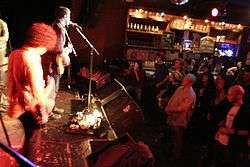Sin-é
Sin-é (/ʃɪˈneɪ/; Irish for "that is it[1]") was a music venue in New York City which helped launch the careers of several noted musicians in the early 1990s.[2]
 A band performing at the final incarnation of Sin-é in 2007 | |
| Location | New York City |
|---|---|
| Owner | Shane Doyle |
| Opened | 1989–96; 2000; 2003-07 (varying incarnations) |
History
Original café
The original Sin-é, located at 122 St. Mark's Place in Manhattan's East Village, was a small café that served food, coffee, and Rolling Rock beer. It was opened by Irish immigrant Shane Doyle in 1989.[3] The early days saw a number of poetry readings and acoustic sessions. One outfit that began to bring in the non-Irish East Village crowd on a Saturday night was known as The Clumsy Cabaret,[4] a late-night gathering that drew musicians (including many of New York's anti-folk scene) after gigs. Acoustic music sessions took place in a spontaneous and creative atmosphere. Patrons included emerging writers, photographers, artists, designers and musicians. Later, as a more established venue, performers played for tips.
Seasoned performers such as Sinéad O'Connor, Jeff Buckley, October Project, Marianne Faithfull, Shane MacGowan, Hothouse Flowers, The Waterboys, Allen Ginsberg, Star Drooker, and the band Native Tongue also appeared at Sin-é, giving impromptu performances. The stage was an area where tables were cleared away against a wall.[2]
The informal atmosphere and devoted regular audience were instrumental in creating a fertile musical scene that flourished until Sin-é closed its doors in 1996. Jeff Buckley's first release was the EP Live at Sin-é (1993), while a double album, Live at Sin-é (Legacy Edition), was released in 2003.
New York's legendary jug band, Porkchop, was the featured Saturday Night band, with Chris Lafrenz on mandolin and vocals, Mike DeSeve on accordion and vocals, Brian Mulroney on washboard and vocals, and JP Bowersock on guitar.
Second incarnation
In 2000, Doyle opened a 380-capacity version of Sin-é on North Eighth Street just off of Bedford Avenue in Williamsburg, Brooklyn.[5] Due to problems with the city and complaints by nearby residents, the club closed after only a few months.[3]
Final venue
Located at 150 Attorney Street, at the corner of Stanton Street on the Lower East Side of Manhattan, the last Sin-é was named "Best New Venue" in NY Magazine's "Best of New York" issue of March 2003. On its first birthday, Sin-é was awarded "Best Place to See a Local Band's First Gig" by NY Magazine (March 2004) for helping nurture acts like The Seconds and The Secret Machines.
In 2004, the adjoining Sin-e Bar opened by Doyle and two others. The venue and bar closed on April 2, 2007, reportedly due to the area's gentrification.[6]
References
- "Foclóir Gaeilge–Béarla (Ó Dónaill): sin". www.teanglann.ie. Retrieved 2018-10-14.
- Browne, David (October 24, 1993). "The Unmade Star", The New York Times; retrieved January 4, 2009.
- https://www.nytimes.com/2007/03/29/arts/music/29sine.html
- ""The Clumsy Cabaret" at Caca Milis Cabaret, archived at the Wayback Machine on August 26, 2013.
- Williamsburg Sin-é, nydailynews.com; accessed April 7, 2018.
- Ryzik, Melena. (March 29, 2007). "Gentrification Blues: Requiem for a Cozy, Unassuming Rock Club", nytimes.com; accessed April 7, 2018.
Sources
- Browne, David. Dream Brother: The Lives and Music of Jeff and Tim Buckley. HarperEntertainment: 2001, 2002; ISBN 0-380-80624-X
- Jeff Buckley Sin-é FAQ
- Wall, Eamonn (2000). From the Sin-e Cafe to the Black Hills. University of Wisconsin Press. pp. 61–64